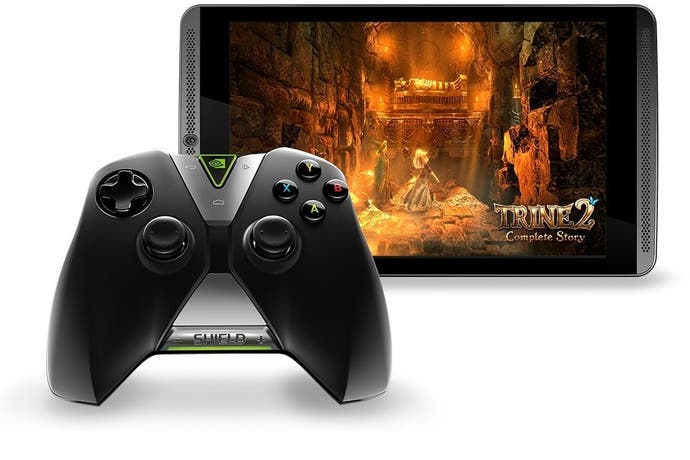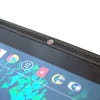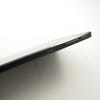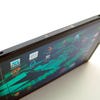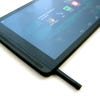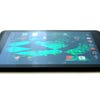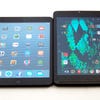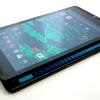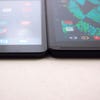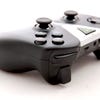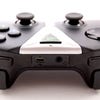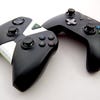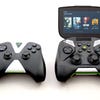Nvidia Shield Tablet review
The future of mobile gaming?
This is it: the product that signifies the transition of the tablet from a browser, media consumption and light gaming device into a new breed of fully portable console. Nvidia's Shield Tablet isn't just an Android slate with an Xbox 360-grade graphics core, it's a thoughtful, well-put together device that aims to appeal to the hardcore gamer, and it's especially useful if you currently own a gaming PC with a recent GTX graphics card. On both a hardware and software level, it's Android evolved.
Let's get the fundamentals out of the way. Nvidia's latest is an eight-inch tablet with a 16:10 aspect ratio display, featuring a 1920x1200 resolution. It's the first indication that the firm has put gaming first: while browsing is just as fast - if not faster - than any other tablet we've used, reading web-pages simply isn't as easy as it is on 4:3 devices like the iPad or Xiaomi MiPad (which features the same Tegra K1 chipset as the Shield Tablet) - both of which possess 2048x1536 "Retina" displays. The resolution deficit isn't really noticeable, but the way that some webpages fit awkwardly onto the screen in portrait mode definitely is. Viewing in landscape has its own problems - namely a lack of verticality. Widescreen favours media and games - that's the Shield Tablet's raison d'tre, and that's where the key trade has been made.
Fitting Tegra K1 into a mini-tablet like this isn't a walk in the park either. The Shield Tablet is hardly big or heavy, but it is thicker and weightier than the Apple competition. That's because K1 running at full power kicks out a lot of heat compared to existing products - that's the price you pay for console-grade performance. You also shouldn't expect the quality of Apple build materials either - Shield Tablet is far from cheap, but it does have a full plastic finish from top to bottom, with a similar kind of rubberised plastic rear to the Nexus 7 tablets. Up against the metallic finish of the iPad, it comes across as functional rather than deluxe.
Other elements of its physical make-up are uniformly positive though: the front-mounted stereo speakers may lack bass but they are some of the best we've seen (or rather heard) on a tablet in this form factor, there's a standard mini-HDMI output (no dongles required), plus a MicroSD slot for expansion up to 128GB. It's powered via a standard micro-USB port, plus there's a stylus too, holstered within the chassis. Based on Nvidia's DirectStylus 2 technology, it uses the capacitive screen rather than a digitiser, with pressure discerned by how much of the stylus tip is pressed against the screen. For the odd bit of sketching and note-taking it is more than up to the task though we suspect that professional artists are best served with the kind of active digitiser found in the Surface Pro.
Booting up the device, we find that once again Nvidia has done the right thing, sticking to standard Android (in this case 4.4.2) as opposed to creating its own skin, with add-on apps where appropriate, most of which are integrated pretty seamlessly. For example, pulling out the stylus automatically spawns a pop-up window with a list of compatible apps, including Nvidia Dabbler (a watercolour painting simulator, if you will) and the ever-popular Evernote.
Other custom software includes the Shield hub, acting as a centralised resource for pad-compatible Android games, pointing you through the Google Play maze to Tegra chipset-optimised titles (along with a special highlight for games with specific K1 features) and providing news curated with core gamers in mind. Here is where you hook-up with your GTX-powered gaming PC to instigate GameStream - a "cloud at home" set-up that allows you to play a large selection of your PC gaming library remotely on the Shield Tablet. It's come on a lot since we last looked at it. Frame-rates are now closer to 60fps (there is still noticeable stutter) and Origin titles are now supported as well as Steam. Image quality is still a touch lacking though and in this respect, we can't help but feel that Steam's in-home streaming is a better option overall (though obviously lacking Android functionality). Gaming is perfectly playable, lag is very low, and it remains a great feature.
Another excellent addition is the ability to save and share footage as you play via Nvidia's ShadowPlay technology - a simple pulldown menu brings up manual and automatic recording options along with the ability to save off a screenshot. Remarkably, Twitch is also supported and the app even allows for you to superimpose the front camera stream over the gameplay video just like the desktop Nvidia app. The system is flexible enough that you are not limited to gameplay - the whole display is streamed at any given point (even the 'desktop') so you can even broadcast from GameStream titles hosted on a Remote PC.
Other Nvidia-specific apps include console mode, allowing you to hook up the tablet to an HDMI screen and turn off the tablet display. This improves performance over the standard mirroring and also conserves battery life too. There's also a bespoke app for syncing up the second major component of the Shield Tablet - the standalone controller. The original Shield integrated physical controls in a clamshell handheld - its successor is a standard tablet with an optional - and rather pricey at £50/$60 - high-tech wireless joypad.
There's nothing stopping you using an existing Bluetooth controller, or even hooking up a wired Xbox 360 pad with a USB adaptor, but the Shield controller offers up a bunch of advantages over and above its generally excellent build quality (think: Xbox One controller). Firstly it utilises WiFi Direct technology, meaning lower latency and much higher bandwidth than Bluetooth. Secondly, there's an in-built mic, good for Twitch streaming or using Google's voice control search features. Thirdly, there's an integrated clickable touchpad allowing you to navigate the OS like a mouse.
Up to four controllers can be paired with the tablet too, giving a console-style experience where supported. Right now, the best showcase for Shield Tablet's enhanced controller support comes from the bundled game, Trine 2, where local multiplayer co-op works just as it does on console. Frozenbyte's platform puzzler is also notable in that it is the first modern console game to be ported across to mobile, making use of Tegra K1's support for the full OpenGL spec - a process you can read about in last Saturday's Digital Foundry piece.
As bundled titles go, Trine 2 is pretty awesome actually. There are some nips and tucks to textures and lighting (only really noticeable in a direct like-for-like comparison) but otherwise this is the PC/PS4/Wii U complete edition ported over to Android, and it's a remarkable showcase for the future of mobile games. Trine 2 always impressed on the traditional desktop and console gaming platforms and aside from some occasionally dodgy frame-pacing issues (which appear to be Android-related as opposed to anything the developer has direct control over) the experience of playing is very similar to the last-gen console versions of the game. It's full 720p (1024x768 on 4:3 Tegra K1 devices like the Xiaomi MiPad) and it runs at 30fps. As a proof of concept, it's superb - this is a 'proper' console game running on a tablet.
Additional comparison:
Unfortunately, while Trine 2 points to a rich future for mobile gaming, other software out now fails to hit the target. We've previously covered Nvidia's ports of Half-Life 2 and Portal running on Tegra 4 hardware via the first-gen Shield handheld and came away a bit disappointed.
The good news is that the code sees significant improvement on K1 devices. We see a full 1080p presentation on Shield Tablet, with quality presets - texture filtering in particular - ramped up significantly. All of this is good news, but unfortunately there are still performance issues on both titles with Half-Life 2 reaching a similar sub-20fps nadir we saw on its Tegra 4 incarnation in certain hotspots.
Bearing in mind that the worst frame-rate drops appear to share a commonality with the same code running on older Tegra hardware, there's a strong possibility that the ports face CPU optimisation issues. While Shield Tablet sees a huge boost in graphical performance over Tegra 4, there's still the same quad-core arrangement of ARM Cortex A15s, albeit running at a higher frequency. It's great that we have two of the best games ever made on Shield Tablet, but the variable frame-rates can be a problem and it's surprising that showcase software produced by Nvidia itself doesn't run better. It's that variance that is the major issue - a 30fps cap option would level out the experience significantly.
Alternative analysis:
Returning to a bunch of existing Android games from our library, we hoped to see these more basic titles run at a locked 60fps. Things started off relatively well with Sonic the Hedgehog 4, Episode 2 running at full frame-rate in its enhanced Tegra-specific edition, featuring additional graphical effects not found on the standard version of the game.
Dead Trigger 2 worked nicely enough, and unlike Sonic, appears to run at native 1080p. However, frame-rate dips kicked in, impacting the fluidity of the experience. Real Racing 3 hit the 60fps mark with only minor drops, but there was notable stutter, making the game feel quite rough to play. Interestingly, this title saw another Nvidia tech emerge - GameMapper emulates touchscreen titles and allows them to run from controller. It automatically kicked in with Real Racing 3 and although it worked, it's clear that emulation isn't really the solution - check out the wild steering seen in the video below, it doesn't feel good to play to be honest.
GTA San Andreas runs easily enough, as you would expect from a PS2-era title, but the game itself appears to implement a 30fps frame-rate cap - accompanied by poor frame-pacing, adding a degree of judder to the experience. The GTA Android titles are notable in that they have a PC-style range of options to tweak with - something Android games could really use owing to the proliferation of different devices out there. It also has a frame-rate limiter, bizarrely limiting the game to 20fps - and there's still judder even then. GTA also has a resolution sliding scale setting too, but even at max we're not seeing native 1080p.
Finally we ran Asphalt 8 - a horrendously jerky sub-native experience we had no real fun playing whatsoever, along with platform puzzler Rochard: 50 to 60fps there, with full native resolution support, but again, similar to our Xiaomi MiPad testing, the game failed to lock to 60fps. However, kudos to the developer there for integrating quality and resolution tweakables - and for handing in an entertaining game in its own right.
Coming out of our gameplay tests with the Shield Tablet we were both excited and a little frustrated. Setting up our little tablet next to much larger and more power-hungry consoles and seeing the mobile chipset hand in an equivalent experience on Trine 2 is one of those moments that makes writing about games technology so rewarding. A mini-miracle? Absolutely. A taste of things to come? For sure. The only slight downer is battery life - running existing Android titles hands in standard gaming longevity, but when Tegra K1 is pushed, it gets hot and devours battery. At 50 per cent screen brightness, Trine 2 lasted two hours, 56 minutes. The MiPad's battery is larger - and Trine 2 at 1024x768 is running at 85 per cent of the resolution of the Shield Tablet version - but over an hour's extra battery life is difficult to explain. The only difference beyond that we could find is that MiPad still runs on the 334.00 GPU driver, while Shield Tablet runs on a later 340.00 revision.
The kicker is that beyond Trine 2, the gameplay situation on Shield Tablet is a little threadbare. The Valve ports are great games but still lack optimisation while 3D Android titles don't scale up particularly well to the new hardware and many come across as rather backward and little better than playing them on cheaper last-gen hardware. Access to the Android library is fine, but after sampling what this kit is capable of with Frozenbyte's title, you can't help but wish that there were more modern console-type games available.
Indeed, right now, there's little else to excite us beyond the raw functionality of the tablet itself. In terms of basic Android functionality, the Shield Tablet is ridiculously fast, but Nvidia's enhancements are generally excellent. The Shield Hub software rationalises the sometimes confusing Android interface and gets you to where you want to go quickly. Controller set-up is intuitive and easy, while the way that the tablet transitions from mobile device to micro-console is superb. Meanwhile, elements such as Twitch streaming and real-time gameplay recording are exceptional additions to a mobile device - PS4 and Xbox One OS features in a mobile device, how about that?
| Shield Tablet | Xiaomi MiPad | Retina iPad mini | Nvidia Shield | MS Surface Pro 2 | Razer Edge | |
|---|---|---|---|---|---|---|
| Geekbench Single-Core | 1123 | 1080 | 1395 | 940 | 2504 | 2440 |
| Geekbench Multi-Core | 3479 | 3451 | 2524 | 2894 | 4762 | 4994 |
| 3DMark Graphics | 35433 | 35317 | 18763 | 17373 | 47841 | 56247 |
| 3DMark Physics | 20250 | 19371 | 8096 | 13814 | 30343 | 33704 |
| 3DMark IceStorm Unlimited | 30372 | 29856 | 14539 | 16382 | 42324 | 48968 |
| GFXBench T-Rex | 64.4FPS | 57.1FPS | 26.1FPS | 24.4FPS | 63.0FPS | 96.0FPS |
| GFXBench Manhattan | 31.0FPS | 28.4FPS | 12.9FPS | - | - | - |
Note: Windows versions of GFXBench currently have no support for the Manhattan benchmark - the silicon is certainly capable of running the test. However, Nvidia Shield lacks the OpenGL support required to run this particular benchmark, hence its omission. MiPad and Shield Tablet run the same chipset, but Nvidia's slate has a later GPU driver (340.00 vs 334.00), perhaps explaining the graphics score differential.
Nvidia Shield Tablet - the Digital Foundry verdict
In essence, Shield Tablet is a product before its time - a well-made though not exactly beautiful slate that nonetheless has all the major foundations in place for an excellent gaming experience. Battery issues aside, the fact that so much gaming power is now available in such a small form-factor is simply phenomenal - but what we need are more games tailored to the new age of mobile technology that Tegra K1 ushers in. High-profile titles where existing OpenGL/SteamOS/Mac versions built on the same OpenGL graphics API supported by the new Nvidia chip could make a Tegra K1 port relatively straightforward. We've seen War Thunder running rather nicely on Shield Tablet (albeit with slightly choppy performance in its pre-production state), but we hope that Nvidia pushes its solid developer partnerships for more titles along these lines.
In the meantime, Trine 2 aside - which is thankfully bundled free with the tablet - there's little in the way of software available to showcase what the Shield Tablet is truly capable of. What we have here is almost like a platform-in-waiting - a ready-made mobile games machine requiring a decent library to get the most out of it. In the meantime, what you're left with is an excellent Android tablet (albeit one not ideally suited to web browsing owing to the screen aspect ratio) that also hands in best-in-class emulation performance - if that's your bag.
Obviously a new era in mobile gaming needs to start somewhere though, and in that respect Shield Tablet is a landmark product. Other mobile chipsets will arrive that equal its performance, and hopefully that will spur on the arrival of more advanced games, but the Shield Tablet's console-style enhancements and controller support should still make it stand out from the crowd even when it's technological advantage has been nullified. Indeed, comparing the MiPad and Shield Tablet side-by-side gives us some idea of how Nvidia's offering differentiates itself - the Xiaomi product is an out-and-out tablet, while Shield Tablet feels more like a hybrid games machine in a slate-like shell. Both have their advantages and disadvantages, but in the here and now, what's clear is that the foundations are now in place for a new phase in mobile entertainment - but what we really do need are more games.
